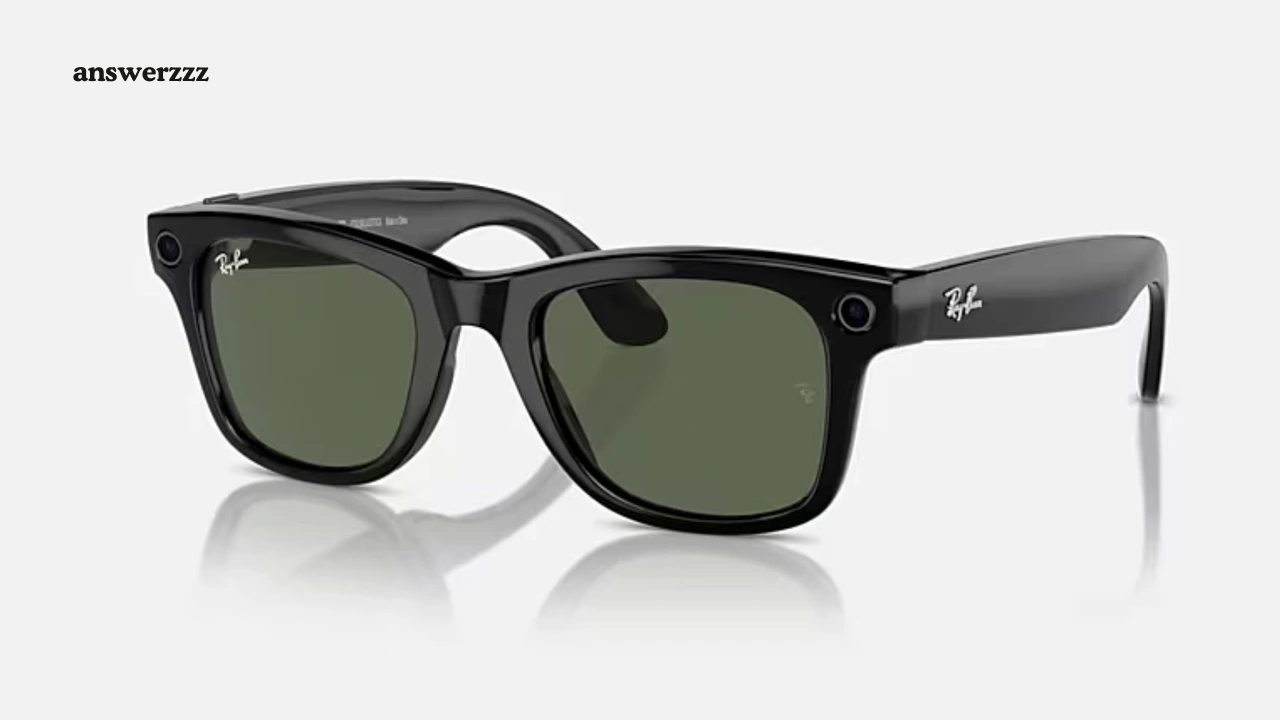In recent years, augmented reality (AR) has evolved from a niche technology to a mainstream innovation, impacting industries from entertainment to education. One of the most significant players in the AR space is Meta, the company formerly known as Facebook. With its deep involvement in social media, virtual reality (VR), and augmented reality, Meta has positioned itself at the forefront of the AR revolution. The Meta Smart Glasses are a part of this strategy, bridging the gap between the digital and physical worlds.
Meta’s smart glasses, launched as a collaboration with Ray-Ban, are marketed as a wearable that offers a new way to experience augmented reality without the clunky, cumbersome design of traditional AR devices. But are these smart glasses a game-changer for AR technology, or are they simply another gimmick in the tech world? In this review, we’ll take a deep dive into the Meta Smart Glasses, exploring their features, design, performance, and potential impact on augmented reality.

Overview of Meta Smart Glasses
Meta Smart Glasses are a product of a strategic partnership between Meta and Ray-Ban, designed to be both a fashion statement and a powerful technological tool. The glasses incorporate features such as built-in cameras, microphones, and speakers, allowing users to engage with AR content in a seamless, hands-free manner. These glasses aim to offer users a more immersive experience compared to traditional smartphones or headsets.
Design and Comfort
One of the most striking aspects of the Meta Smart Glasses is their design. Unlike bulky VR headsets or AR glasses that have traditionally been associated with geeky, industrial looks, these smart glasses are sleek and stylish. Designed by Ray-Ban, the glasses come in several frame styles, including the classic Wayfarer, as well as other iconic Ray-Ban designs. The frames are lightweight, ensuring comfort for extended use, which is a huge selling point for a device meant to be worn throughout the day.
The glasses are also built with durability in mind. The lenses are scratch-resistant and come with UV protection, making them suitable for everyday wear. Additionally, the glasses are designed to be discreet, with the AR capabilities hidden beneath the surface, making it difficult to tell that you’re wearing a high-tech device. This is an important consideration for people who want to embrace AR without drawing too much attention to their wearable tech.
Google Nest Hub 2026 Review: A Comprehensive Look at the New Features
While the glasses are designed to be stylish and comfortable, there are a few limitations. The frames may be too large or heavy for some users, especially for those who prefer ultra-light wearables. However, the trade-off is the inclusion of cutting-edge technology, which requires space in the design.
Augmented Reality Capabilities
At the heart of the Meta Smart Glasses is their AR capabilities. However, it’s important to note that the glasses themselves do not offer full-fledged augmented reality experiences like those seen in more advanced AR headsets (such as the Microsoft HoloLens). Instead, the Meta Smart Glasses are designed to enhance your environment with digital overlays and provide a more interactive experience when paired with a smartphone.
The Meta Smart Glasses are equipped with a pair of built-in cameras that can capture the world around you. These cameras are capable of recording videos and taking photos, which can be instantly uploaded to social media or saved to your phone. However, the cameras are not as powerful as those found in other devices, such as smartphones, and the image quality may not meet the expectations of professional photographers or videographers.
The AR experience provided by the glasses is primarily delivered through the companion smartphone app. Once connected, users can access AR content such as virtual objects, real-time translations, and contextual information displayed over real-world scenes. For example, imagine walking into a museum and seeing virtual plaques floating above exhibits, providing detailed descriptions of the artwork without having to look at a separate screen. The glasses enable a truly hands-free experience, freeing users from constantly looking at their phones.
Additionally, the glasses have speakers and a microphone, enabling you to take calls and interact with voice assistants such as Meta’s own AI or Google Assistant. This functionality is particularly useful for users who want to stay connected without reaching for their phone, offering a more immersive and convenient AR experience.
While the Meta Smart Glasses provide a basic AR experience, they are still far from offering the fully immersive AR experiences of more advanced systems. For instance, you won’t see holograms of people or objects floating around you in 3D space, nor will you be able to fully manipulate virtual objects with your hands, as seen in more advanced AR headsets.
Camera and Audio Performance
The camera system on the Meta Smart Glasses is perhaps one of the most talked-about features of the device. With two 5 MP cameras built into the frames, these glasses allow users to capture photos and videos discreetly. The cameras are positioned near the temples of the glasses, designed to look like normal lenses, so they don’t draw attention to their purpose.
The quality of the images and videos is acceptable but not groundbreaking. While it’s good enough for casual social media sharing, it doesn’t match the quality you’d get from a dedicated smartphone camera. The 5 MP resolution is adequate for general use, but users hoping for professional-grade photography may be disappointed.
The built-in speakers are another noteworthy feature. The glasses use bone-conduction technology, meaning they transmit sound through vibrations in your skull rather than relying on traditional speakers placed inside or over the ears. This allows users to hear audio while still being aware of their surroundings. The sound quality is clear and provides a decent listening experience, but it might not be as immersive as other forms of audio delivery, such as over-ear headphones or in-ear earbuds.
The microphone performs well for voice commands and taking calls, but like the camera, it’s not as sophisticated as what you’d find on other high-end devices. The audio quality for calls is acceptable, but in noisy environments, the microphone may struggle to pick up your voice.
EcoFlow Delta Pro Review: Is This the Best Portable Power Station?
Battery Life and Charging
One of the biggest concerns with wearable tech is battery life. Fortunately, Meta Smart Glasses are designed to be energy efficient. The glasses are equipped with a rechargeable battery that lasts approximately 6 hours with regular use, including calls, music, and occasional camera activity. This is a reasonable duration for a device of this type, but it’s far from the all-day battery life that many users might expect from a wearable.
Charging the glasses is relatively easy. The device comes with a charging case that can provide additional battery life, ensuring that the glasses stay charged while not in use. However, it’s important to note that charging the glasses fully takes around 1 to 2 hours, which might be inconvenient for users who need quick top-ups.
App Integration and Ecosystem
The Meta Smart Glasses rely heavily on their companion app, which integrates with a user’s smartphone to deliver AR content and control various features of the glasses. The app itself is straightforward to use and offers features such as customization of the AR interface, controlling music playback, and managing settings.
The integration with social media platforms is seamless, allowing users to instantly share photos and videos captured through the glasses. For instance, you can record a video hands-free and immediately upload it to Instagram or Facebook, making the glasses a valuable tool for social media influencers and content creators.
However, while the app offers a convenient interface for managing the glasses, it’s still a work in progress. Users have reported occasional glitches and bugs, such as difficulty pairing the glasses with smartphones or inconsistent AR performance. As the ecosystem matures, these issues will likely be resolved, but for now, the app still feels somewhat basic compared to other tech ecosystems.
Privacy and Security Concerns
As with any device that includes cameras, microphones, and data collection capabilities, privacy and security are major concerns with the Meta Smart Glasses. Users may feel uneasy about the idea of wearing glasses that could potentially record their every move. While Meta has assured users that the glasses are designed with privacy in mind—such as notifying those nearby when a video is being recorded—the potential for misuse remains.
Moreover, the data collected by the glasses, including images, videos, and voice recordings, is stored in Meta’s cloud system. Given the company’s history with data privacy issues, it’s essential for users to carefully consider how comfortable they are with Meta’s data practices before investing in the device.
Is It a Game-Changer?

So, are the Meta Smart Glasses a game-changer for augmented reality? The answer depends on how you define a “game-changer.” If you’re looking for a device that provides fully immersive AR experiences and revolutionizes the way we interact with digital content, the Meta Smart Glasses fall short. However, if your definition of a game-changer is a device that introduces AR into everyday life in a way that is both stylish and practical, then the glasses have the potential to be just that.
The Meta Smart Glasses are an excellent starting point for consumers looking to dip their toes into the world of augmented reality. They offer an introduction to AR in a familiar and accessible form, with a focus on style, convenience, and social media integration. While they may not replace smartphones or VR headsets in terms of functionality, they are a valuable tool for those looking to experience AR in a hands-free and everyday context.
The Meta Smart Glasses are a fascinating glimpse into the future of augmented reality. They combine style, practicality, and cutting-edge technology in a way that is accessible to a wide audience. While they may not be the fully immersive AR experience that some might have hoped for, they are undoubtedly a step forward in making AR a part of daily life. Whether or not they can revolutionize the AR market remains to be seen, but for now, they offer a compelling vision of a future where digital and physical worlds blend seamlessly.




